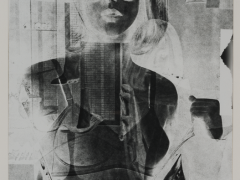A book, a day: The Writing on the Wall By Roger Perry
“Every f**ker and his granny thinks that street art is about stencils by some bloke called Banksy but I've seen the past and it's about the writing on the wall, literally” says King ADZ.
“The first piece of graffiti that ever got me going was the classic 'If it were a lady it would get its bottom pinched' Fiat 127 billboard which someone had tagged in big black spray ‘if this lady was a car she’d run you down’... f**king genius, they don't make them like that anymore! Her words (it had to be a woman who called that) summed up all that was great about the English: political, funny, satirical, and resistant. And it’s the same four words that I would use to describe The Writing On The Wall By Roger Perry, which is a unique distillation of a London that no longer exists, either physically, politically, or mentally. It’s a lekker book about street poetry written large in a scrawly hand on walls that probably crumbled a long time ago, but the messages, the humor, and the rhetoric still live on. If you’re into street art then you gotta come correct otherwise you’re just fessing…” He is absolutely right.
Following a successful Kickstarter campaign in September 2014, Roger Perry’s legendary and long-out-of-print book of London graffiti photos, The Writing on the Wall, is being republished. After 38 years out of print, Perry's unique survey of London graffiti of the mid '70s is finally going to be available once more.
Just as relevant nearly forty years on, Perry's book is as much a cultural history of London at the time as it is a graffiti book. Before the 'wild styles' of New York came over to this fair isle, graffiti was the reserve of poets, comedians, and counterculturists. The graffiti in this book has more in common with Blake than Basquiat. Through Perry's lens, we are offered a glimpse of Notting Hill which gave rise to the counterculture movements and underground press of the '70s.
Last seen in 1976, Perry’s book has taken on a mythical aura amongst collectors, thanks partly to Jon Savage writing about it in his celebrated 1992 history of punk, England’s Dreaming. “In 1975, graffiti was a shorthand way of accessing the mood of the time. In the 60s and even the early 70s, music reflected the environment and how people felt and thought about things – and that was almost gone. Pop wasn’t doing its job, it wasn’t the teenage news. Graffiti was like a secret code, the voice of the underdog. It was people telling you things you couldn’t read in mainstream media and wouldn’t necessarily think about. You’d get jokes, stoner, and outcast humor, with serious points. It was another kind of language.”
As a result, second-hand copies of the original book can command upwards of £80. This new edition is expanded and features over 40 unseen photographs, an extensive foreword by George Stewart-Lockhart and a short story by Bill Drummond. A number of Perry’s friends and colleagues, from various points in his career, have contributed to a biographical section at the end of this curated collection of pure brit graffiti, made up of Roger Perry's black and white photographs of '70s London. A unique glimpse of a multicultural London told through poetic statements daubed on squatted houses and corrugated iron fences, these statements would be forever lost to decay and demolition if it weren't for Perry's obsessive documentation of them.
The book was originally published just as graffiti books were beginning to be in vogue. Norman Mailer and Jon Naar's The Faith of Graffiti had just come out, covering the scene in New York at the time. The Writing On The Wall, though, was the first one really dedicated to London graffiti.
The majority of the graffiti here could be described as 'Pre-Renaissance' in many ways. No one would be describing this stuff as 'art' until Martha Cooper and Henry Chalfant's Subway Art made it across to these shores in 1984. This work was mostly anonymous, and to paraphrase Marshall McLughan, the medium was the message. It wasn't important how it had been written, it was simply the fact that one person felt it important enough that it should be painted on a wall for all and sundry to see.
The book is being redesigned by Pearce Marchbank, who worked on the original nearly 40 years ago, and is a must-have for anyone who appreciates the language of the writings on the wall. Guardian's Alexis Petridis writes:
“Some of the graffiti in the book is absurdly funny or strangely wistful: 'Remember The Truth Dentist', 'Cats Like Plain Crisps', 'We Teach All Hearts To Break' on the wall of a school. Some aren’t: 'Go And See Stardust With David Essex It’s Really Great.' Exactly who was responsible for what is unclear; Thompson aside, the authors usually chose to remain anonymous. But a lot of the slogans in the former belonging to absurdly funny in that first category were the work of poet and dramatist Heathcote Williams, then involved with an anarchist group called The Albion Free State. 'Why graffiti?' he says. 'A lark. The anonymity is appealing. It’s not signature art. It’s just a thought, which can either be the view of a lone crank or be the view of thousands. It’s up to the reader to decide. They bubble up in an engagingly mysterious way. You think, 'What’s that doing there? Who on earth wrote that?'”
Own your copy of The Writing on the Wall By Roger Perry here.
Tags/ origins, book, graffiti, punk, street art, british, roger perry, walls





























